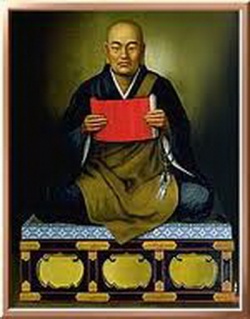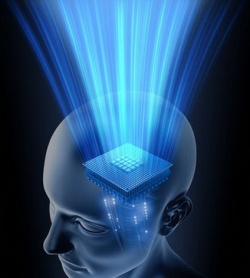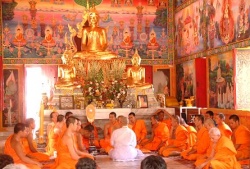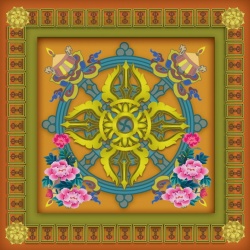The Role of Religion in the 21st Century
A Report on the Board of Director's Seminar '97
On June 29, 1997, our Higashi Honganji North American District sponsored a stimulating and thought-provoking seminar for District Board of Directors entitled, "What is the Role of Religion in the 21st Century?" The keynote speaker was Dr. Michael Kerze, Ph.D in the History of Religion and an acknowledged expert in world religions. Dr. Kerze is the former director of the Interfaith Council at Occidental College (where he became good friends with Rinban Ito, who also taught there), and is currently teaching at Loyola Marymount University.
Interestingly, Dr. Kerze is Catholic by birth and also co-chair of the Catholic-Buddhist Council. Presumably, Rinban Ito chose Dr. Kerze to address our temple leaders because, although he is Catholic, he is a most unusual one. At many times during his lecture, he seemed, for all intents and purposes, to be speaking as a Buddhist.
The event also featured a lively panel discussion with Rinban Nori Ito, Rev. Kiyota, Dr. Kerze, Rudy Gomez of the Betsuin, Ronnie Young of Newport Beach and Art Yamashita of Berkeley. Peter Hata of WCBT served as moderator.
Dr. Kerze began his address by stating, "It is a joy to be here at your temple; let me say I am struck by what an interesting thing is going on in my life...here I am a local Catholic boy, but one who also studied D.T.Suzuki's books on Buddhism. And, when I studied other religions, I discovered this was the greatest resource for me to understand my own religion."
Regarding the word "religion," Dr. Kerze defined it as deriving from the Latin religio, meaning "bind together." This is a key concept. Specifically, he clarified that there are three things that are "bound." First, religion binds people, forming community (Buddhist's "Sangha"). Second, it binds the past and present through its teaching, and thus forms a tradition. Third, it binds the human and "sacred" around a "sacred and transcendent reality," meaning that religion opens our consciousness to the spiritual dimension.
However, as Dr. Kerze pointed out, there are unfortunately many things that work against religion. For instance, many parents often find themselves unable to understand how their children can have values totally foreign to their own. "Media marketing" (TV ads, radio ads, print ads, etc.) is often geared towards a particular age group, such as the youth, which has the effect of separating generations. The term "market culture" was coined by contemporary writers and social critics to identify the kind of sub-culture or mentality that massive media marketing has created today.
Dr. Kerze also pointed out that one of the problems that a highly media and materialistic-oriented society creates is that we "tend to be robbed of our compassion." In addition, he said, youth-targeted marketing, especially with regard to the sexually suggestive ads we see everywhere, "seems to eroticize the young, which often leads to abuse and relational problems."
Clearly, this "market culture" is transforming society; there are massive job losses, the traditional community seems to be disappearing, the workplace is less stable and, due to the increasing rate of change and "future shock," we are becoming a more "transient" community. Other effects of our market culture are alienation, pollution, and an epidemic of cancer-related diseases. And regarding the tremendous influx of technology in everything we do, Dr. Kerze said, "We understand by what we make, which is technology. Today, computers have captured our imagination."
The question, as Dr. Kerze pointed out is, "What does this market culture, driven by technology, mean for religion? Is the same thing true with our religious traditions?," i.e., have old traditional values been replaced by more "modern," materialistic and/or technological ones? Dr. Kerze explained that market culture, because it is so successful materially, has really become our modern-day mythology. Perhaps it might be said that it has become a "religion" for some. But , as Dr. Kerze stated, "Unfortunately, something is lost for everything gained."
Related to rise of market culture has been the advent of the so-called 'Mega Church,' which usually has between five and ten thousand members. "They provide child care, gyms, beauty parlors, counseling services...in essence, a ready-made community. And community is something we all seek," Dr. Kerze said. These churches have obviously embraced the market culture, and use its marketing techniques to increase membership. Not surprisingly, they are usually of an "evangelical" nature, and generally provide a very simple set of rules to follow and a stable system of teaching.
Why are the Mega Churches so successful? Dr. Kerze pointed out that it is most likely because we instinctively want to be bound together. People could get the same services elsewhere, but often choose to get them from their local church, since it is their community. "But," Dr. Kerze asked, "should these mega churches be our 'model' for the community of the future?"
Dr. Kerze observed that there are other models. There is the "meta community" model, which is built upon concepts of pluralism and cultural diversity. An example: "There are currently about 500,000 Buddhists in the Southern California area," he said. It is unprecedented to have so many Buddhist schools in one geographical area. To Dr. Kerze, "LA is definitely the most exciting Buddhist city in the world." There are new and exciting dialogues taking place here. Organizations of Buddhists are in turn forming larger organizations; in effect, an "intra-Buddhist community."
Dr. Kerze related an interesting experience he had recently: "I participated in an ordination ceremony that had Theravada, Mahayana and Vajryana ministers all present at the same time." According to Dr. Kerze, this kind of "intra-Buddhist community" works because "No one is asked to compromise their religion; there is an attitude of respect. It is highly stimulating for all involved," he said.
Market culture, the media and technology are, of course, not all bad; they offer methods to strategize for the future, as the mega-churches have shown. Witness also the greater media presence of informative documentaries on religion that PBS for example has produced recently; shows on Joseph Campbell, Bill Moyers recent "Search for God in America," etc.
However, Dr. Kerze asked, "Where does the 'sacred' fit in?" He quoted from noted writer Robert Wothrow, who said, "The health of society is dependent on the sacred." Dr. Kerze explained that this is because the sacred deepens and enriches our lives, and gives our lives meaning and purpose. Thus in a larger sense, the sacred is ultimately crucial to the health of society, and even to the health and harmony of the world-wide community of human beings.
How is the "sacred" produced? It is produced by religious communities (churches), which are in many ways, the center of our social communities. Dr. Kerze reminded us that "Religion binds community, tradition and the sacred." Furthermore, churches "provide a space for rituals that make the experience of the sacred possible." But a key point is that one must first leave the market space and retreat from the everyday hustle-bustle.
Regarding the "binding of the human and sacred," Dr. Kerze called it "the most difficult thing...the sacred is the most difficult to define, since it is out of the realm of human experience; it is transcendent." And to Dr. Kerze, the question remains, "Where will the sacred be found in our 21st century market culture?" The problem is, as Dr. Kerze explained, that "Market culture deprives us of essential 'nutrition'; in a sense, it is like 'junk food.' Materialism, if we get too caught up in it, leaves us empty."
Thus, Dr. Kerze feels it's not surprising that there is a great rise in meditative and contemplative practices, certainly in Eastern religions, but even amongst Catholics as well. "These are by and large, grassroots, lay movements," he said. And this rise in lay groups of people seeking the sacred is due to organized religions not filling their needs. There is a need to "remove" the influence of market culture. Dr. Kerze closed his talk by saying, "One of the services of the 21st century church should be the removal of market culture...Perhaps Jodo Shinshu can be of great benefit to our market culture."
Question and Answer Period:
After a break for lunch, there was a short question and answer period. One member asked if we should try to simplify the teachings without compromising them, along the Mega Church model. Dr. Kerze agreed and replied that "It's a matter of how to be authentically Jodo Shinshu and in the market...and we're all in the market whether we like it or not...now, how do you make the Jodo Shinshu Dharma more "user-friendly, more accessible?," he asked. He advised Shin Buddhists to "Remain open"-like the market itself-and ask, "What service can Jodo Shinshu provide?...How can we meet the needs of society? What are the needs of families in our community?"
In fact, Dr. Kerze advised forming a "Market Strategy"; that is, figure out what you want, need and what the market wants and needs. Then prioritize. "This is the strategic planning process," he said. The focus should be the issue of "how to be Jodo Shinshu, authentic to the Dharma, and in the market."
One of the most interesting moments came when Dr. Kerze was asked about the Shin teaching that "I-not 'society'-am the problem," i.e., that perhaps the problem is not market culture, the media, etc., but really us or, more specifically, me." Dr. Kerze paused for few seconds and then thoughtfully answered it this way: "To say 'I am the problem'...is the most difficult thing...but it is the most unique and wonderful teaching...it is a treasure."
Panelist's Comments:
Following the question and answer period, the panelists had the opportunity to make comments. Rinban Ito pointed out that "Mega churches are successful because for the most part, they merely affirm the beliefs of their followers...but Buddhism offers another perspective." Ronnie Young emphasized that "We should concentrate on "delivering Dharma." Responding to Dr. Kerze's statement that "Jodo Shinshu is very appealing," Peter Hata remarked, "But as far as effectively communicating that Dharma goes, in some ways, movies like George Lucas' Star Wars, and Disney's Beauty and the Beast and Lion King have done a better job of communicating Buddhism to Americans than Buddhists have." Rudy Gomez stated, "What do people want? Know that, then the market culture can work...we must provide a service." Art Yamashita reminded us that "The temple should be a factory for producing true human beings. It should work to bring people together."
Dr. Kerze's Summary:
"Thank you," Dr. Kerze began, "What a privilege it is to hear your members discuss the Jodo Shinshu tradition. It is really 'hearing the tradition discussing itself...seek guidance from your own tradition about creative ways to spread the tradition," he encouraged. He also emphasized that, while the market culture has produced negative effects in our society, it also certainly has created many positive opportunities for communication through technology." Dr. Kerze mentioned his joy of being able to visit WCBT's Living Dharma website where he read, among other things, a sermon by his friend Rinban Ito.
The mega churches, with their evangelical tradition, tend to measure success through growth of their congregations. "But," asked Dr. Kerze, "is this what Jodo Shinshu should measure itself by?" We have to ask ourselves first if we really want Jodo Shinshu to grow or expand And if so, he said, "how do we measure it?"
Dr. Kerze closed his summary thoughtfully by remarking, "This is something you have to figure out...however, I must say for myself that you have something unique and utterly beguiling."




